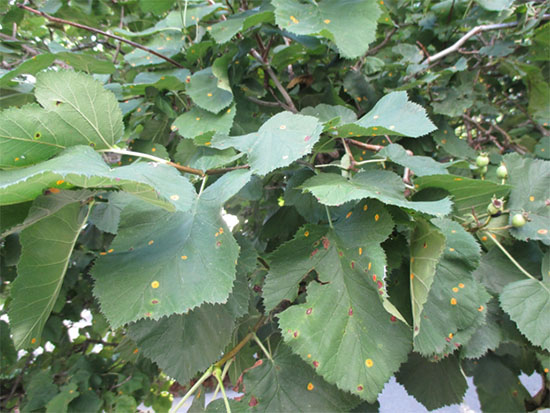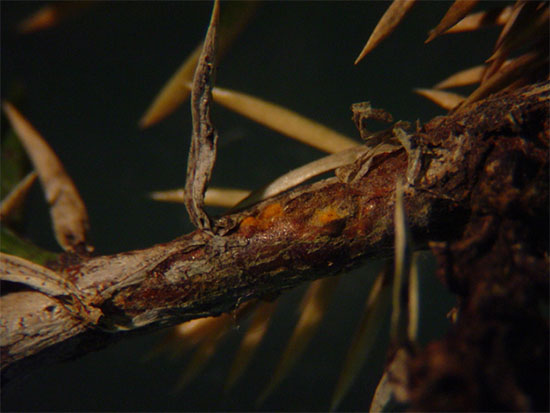Issue 13, August 3, 2015
Rusts on Apple and Hawthorn
We're finally seeing some beautiful weather for this time of year, with days full of sunshine and moderate temperatures. We're not the only ones enjoying the outdoors; we share it with animals, insects, plants, and of course, plant pathogens. One common problem that's rearing its ugly head is rust on apple trees and hawthorns.
Rust diseases are caused by fungi, and affect a wide range of plants including field crops like corn and soybeans, fruits like raspberry, evergreens like junipers and white pines, ornamental plants like daylily and lily of the valley, turfgrass, and deciduous trees. Many rusts require two hosts to complete their lifecycle, and can produce up to 5 different types of spores in the course of one year. Rusts are complicated diseases that have been affecting humans since ancient times.
Rust lesions are a common problem on apple and hawthorn trees in Illinois every year. Most are caused by three different rust diseases: cedar-apple rust, cedar-hawthorn rust, and cedar-quince rust.
As the name suggests, cedar-apple rust affects apples and crabapples (Malus spp.) and eastern red cedar (Juniperus). Both the apple and the cedar hosts are necessary for the fungus (Gymnosporangium juniper-virginianae) to reproduce. On apples, lesions can occur on the leaves, fruits, and twigs of affected trees. First appearing as pale yellow spots on the upper surface of the leaf, as the lesions develop they become larger, with a dark orange-brown center. Eventually, the fungal infection reaches the underside of the leaf and small tube-like structures develop. These structures, known as aecia, release thousands of aeciospores to be blown by the wind, settle on a juniper plant, and begin infection of the new host. For ornamental apples and crabapples, the aesthetic impact of discoloring lesions on the leaves is the greatest problem. Severe infection can result in leaves becoming completely yellowed and premature defoliation of the tree.

Cedar-apple rust lesions on apple leaves began to appear in early July in central Illinois. Photo credit: Diane Plewa
Similar rust lesions are also developing on hawthorn trees at this time. These lesions are caused by a different rust fungus (Gymnosporangium globosum) which causes cedar-hawthorn rust. It can also infect others in the rose family including apple, crabapple, serviceberry, and pear. Once again, both the deciduous tree host and the cedar host are needed for the fungus to go through its entire lifecycle. As on apple, the first symptoms on hawthorn are small, pale yellow spots on the top side of the leaves which develop into larger, darker lesions surrounded by a yellow halo as the infection progresses. Aecia develop on the bottom surface of the leaves as the infection progresses, and the aeciaspores released will infect cedar plants. This pathogen can also cause leaf yellowing and premature defoliation on heavily infected trees. Certain species of hawthorn, including downy hawthorn seen below) are considered very susceptible and may incur heavy damage.

Cedar-hawthorn rust lesions on hawthorn leaves began to appear in early July in central Illinois. Photo credit: Diane Plewa
There is a third rust disease in Illinois that affects cedar, cedar-quince rust. This pathogen (Gymnosporangium clavipes) can affect numerous members of the rose family, including serviceberry, chokeberry, quince, hawthorn, and apple, among others. This fungus forms lesions along leaf petioles and leaf veins, and may cause damage to stems and fruits of susceptible hosts. This pathogen is the most damaging to the coniferous host, causing branch cankers that can cause severe dieback and death. Cedar plants should be scouted for rust-colored growths on branches in early spring, especially if dieback was noted the previous year.

Cedar-quince gall on cedar, under magnification. This gall will girdle the branch, leading to dieback on the host. Photo credit: University of Illinois Plant Clinic
Control for deciduous host rust symptoms include the use of a wide range of fungicides (the most common being chlorothalonil, myclobutanil, potassium bicarbonate, and propiconazole). Chemical treatments need to be applied early in spring at the pink flower to bud stage, and are continued at the labeled interval for 1 to 2 weeks past petal fall. Resistant varieties are available, and should be considered for ornamental use. (Diane Plewa)
Author:
Diane Plewa